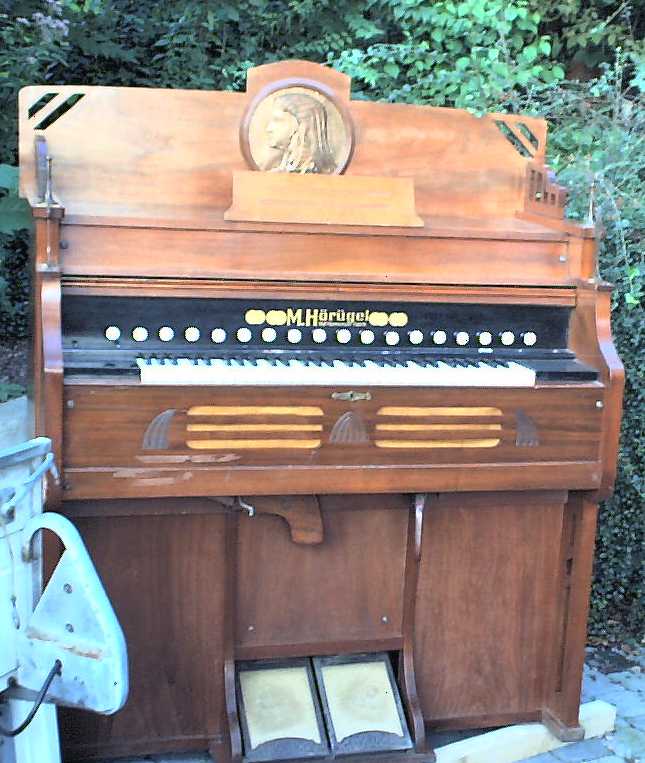 |
|
... notes from my workshop: Restoration projects 4Reed Organ
Hörügel Hof-Harmonium, ca. 1914
This is a suction type, one-manual reed organ in a "Jugendstil" style case. The wood is walnut veneer, stained light brown, the decorations are typical for that decade. Look at the brass plate at the top showing a head in a "hellenistic" outfit.
 |
|
Stop List Speaking Stops Bass Aeolus-Harfe 2'+ 2', fading tremolo (celesta) Cornettino 2' Bourdon 16' Viola 4' Viola dolce 4' soft Diapason 8' Dulcet 8' soft Discant Echo 8' (front) Melodia 8' (rear) Vox Celeste 8' + 8', fading tremolo (celesta) Flute 4' Clarinette 16' Waldhorn 16' (in separate qualif. chamber) not in "Grand Jeu" Non-speaking Stops Bass Koppel on bass section only Discant Koppel on discant section only Bass Forte Discant Forte Vox Humana Fan Forte lever Knee lever Full Organ (Grand Jeu) lever Knee lever So the instrument has one 4' set and double sets of 8' resp. 16' reeds in the discant section; the bass section has one 8' , 16' , 4' each and a double 2' set.
The soft stops are derived; the fully derived "Vox Celeste" is created by a combination of the two 8' reeds of the front set and the rear set. The "Äolsus-Harfe" (Aeolian harp) in the bass section is a combination of the two 2' sets. The reeds of the "Waldhorn" stop are housed in a separate qualifying chamber and give a full, warm "brass" sound, good for solo parts.
The keyboard has a compass of 5 octaves, F - f3, divided in the middle between b and c1.
The coupler is divided: the "Discant Koppel"couples the keys of the discant section one octave up, the "Bass Koppel" the resp. keys in the bass section one octave down.
History
The serial number is 26046, so the Instrument should have been built in between 1913 and 1915, probably in 1914. The organ was at last used in a little church in the Eifel region (near Aachen) until ca. 1990. Then a member of the congregation took it to his home, where it served as a decorative furniture.
Hörügel Company
According to Gellerman's Reed Organ Atlas, the Hörügel (often mis-spelled as Horugel or Horügel) Company was located in Leipzig-Leutsch, in the eastern part of Germany (Saxonia). The company has been founded in 1872 or 1893 (sources vary) and went out of business in 1952. "Largest harmonium factory on the European continenT"(1903). Annual production 2,000 instruments in 1904. Specialized in suction instruments, also made a three-manual and pedal harmonium.
Serial Numbers:
1905 - 8634 1925 - 36792 1950 - 44680 1910 - 18486 1928 - 40000 1951 - 44900 1913 - 25000 1931 - 42830 1952 - 45100 1915 - 28951 1935 - 43380 1920 - 31948 1940 - 44000 Restoration
The Instrument was in rather fair condition and was playable. Nevertheless, the bellows had to be fixed, and the whole instrument needed cleaning and adjustment.
Case
The polish had to be renewed. I used tung oil. The candle (halter) are incomplete, I'm still looking around to get spare parts for them. Some screws were missing and some had to be replaced.
Lower action / blower
The bellows had to be tightenend; a complete restoration was not necessary at this time.
Upper action
The upper action, particulary , stops, mutes and couplers, had to be readjusted. The gaskets, some leathers, felts and the "Vox humana" fan had to be replaced.
Reeds
The Reeds were good in tune, at a = ~ 440 Hz. They just got some cleaning.
Summary
A Instrument for "romantic" music. The bass/discant division in the middle (b-c1) of the keyboard leaves little compass for the right hand. The fading, vibrating stops "Äolus Harfe" and "Vox Celeste", combined with the "Vox humana" fan, give a vibrato effect so strong that you might get the illusion to hear a Hammond Organ ...
Any questions ? Please contact me by e-mail: martin.r@gmx.de

Optimized for a resolution of 1024 x 768 pixels
DISCLAIMER
This website may contain links to other web sites. The owner of this site is not responsible for the contents of the web pages linked to. Due to German jurisdiction, the owner has to dissociate himself from other's sites contents. So I do this.
PREVIOUS - HOME - NEXT
J M. Rutenfranz last updated: 23 March 2001 martin.r@gmx.de